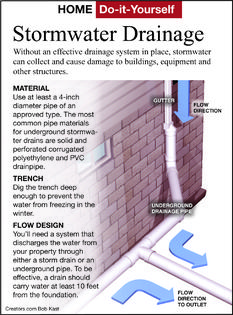Here's How: Design a Gutter-Drainage System Properly
Dear James: Our old house had gutter drainage problems that flooded our landscaping. While we are planning our new house, what are some design tips to avoid similar problems? -- Cory T.
Dear Cory: You may not notice a drainage problem initially, but it often develops several years after a house is built and gradually worsens as sediment builds up. For people with crawl spaces and basements, this can be a problem more serious than just harming the flowers in their gardens.
Using splash blocks under an open gutter downspout to disperse the water may be effective in areas with little rainfall and loose, well-drained soil. Unfortunately, in many areas of the country, heavy clay soil is quite common, and it does not allow water to readily pass through it.
First, think about how much water actually hits your roof when it rains. More than 1,000 gallons of rain water will hit the roof of a 2,000 square foot house with 1 inch of rainfall. During a rainy period, the ground is already saturated, so this water will build up around your house. It often finds the path of least resistance into your house.
The key to avoiding problems like you had in your previous house is to install the gutter drainage system properly from the start so it pipes this rainwater away from your house. It requires planning, careful installation and additional work, but the overall cost will not be substantially higher.
Most areas will not allow you to tie your gutter drainpipes into the city storm sewer system, but check to make sure. That is often the simplest method. In general, though, you will have to locate the lowest area on your lot and plan on making that the drainage outlet. Also consider the location of your neighbor's home so that you do not flood them out.
Many builders use standard black corrugated or thin-wall 1,500-pound crush weight underground drainage pipe. This holds up for a while, but it is relatively weak and roots can grow through it. The corrugated pipe can also be difficult to clean out thoroughly should a clog develop.
The best two drainage pipe materials to have your builder use are standard schedule 40 PVC pipe or SDR 35 pipe. Schedule 40 pipe is the type of drainage pipe that is used inside of homes. It has a thick wall that can support the weight of the soil. The joints are assembled by solvent welding, so there are no leaks where roots naturally seek out the moisture.
SDR 35 pipe is not quite as thick as schedule 40 pipe, but it is still very strong. Select the type that has male and female ends for the best seal at the joints. It uses rubber gaskets to provide watertight joints. To assemble it, use some dishwashing liquid on the gaskets so that they slip together easily.
If you need 90-degree bends in the drainage pipes, do not use 90-degree elbows. These create a dramatic change in the water direction, which causes much resistance to the flow. Use two 45-degree elbows instead with a 1-foot straight section between them. This also makes it easier to clean out a clog if it forms.
Ask your builder to lay the drainage pipe several feet from the house in virgin soil that was not disturbed during foundation excavation. If the pipe is laid in backfilled soil near the house, it may settle just enough to create a negative pitch in spots where water will stand. Fill all areas under the pipe so that it does not bridge voids and have to support the weight of the soil above it.
========
Send your questions to Here's How, 6906 Royalgreen Dr., Cincinnati, Ohio, 45244 or visit www.dulley.com. To find out more about James Dulley and read features by other Creators Syndicate writers and cartoonists, visit the Creators Syndicate website at www.creators.com.
Copyright 2025 Creators Syndicate Inc.






























Comments